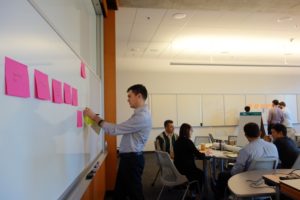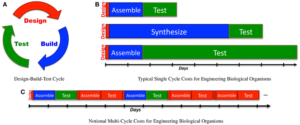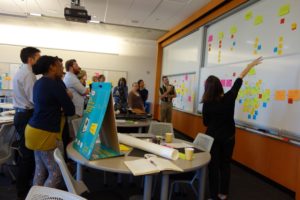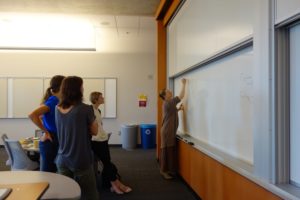by Annie Hammang
In late 2016, Engineering Life hosted the third of its fourth experimental workshops, on Mapping Synthetic Biology Workflows. Collaborative work between engineering biology (or, alternatively, synthetic biology) and the social sciences has been around nearly as long as the field has. But while opportunity for collaborative work abounds, how to go about this collaboration isn’t always straightforward. How to get individuals with different research goals, disciplinary jargon, styles of knowing things, and, importantly, relative power in shared projects, working productively on a shared goal or object, is far from obvious. This particular interdisciplinary workshop went well enough that we decided it would be worth sharing in a report.
The workshop in question was a day-long event hosted at Arizona State University, organized around the idea of ‘workflows’ in synthetic biology. A banal enough seeming object, workflows can be seen to exemplify a key aim of synthetic biology – to make biological research more efficient by borrowing tools and practices from engineering. As social scientists on the Engineering Life team, we have grown used to seeing images of cyclical workflows containing “design,” “build,” “test,” and sometimes “learn” elements in synthetic biology presentations and articles. But we were curious to understand what lies behind this seemingly simple representation of work. Despite the consistency of this particular symbol in the field’s self-presentation, how you actually make biological work more efficient – with its tacit knowledge, lab drudgery, and capricious microbes and enzymes – is far from obvious to an outsider (and maybe even to an insider). And importantly, it’s not clear that this is strictly a technical exercise. Value judgements and priorities are made along the road in deciding what practices to streamline, automate, or re-work; and so, a workflow, in an oblique, innocuous way, can open a conversation into what changes in practices, priorities, and knowledge production are underway in the field.
Image credit: Bridging the Gap: A Roadmap to Breaking the Biological Design Barrier – Scientific Figure on ResearchGate. Available from: https://www.researchgate.net/figure/When-analyzing-synthetic-biology-against-a-classic-design-build-test-cycle-A-analysis_fig8_272080725 [accessed 25 Feb, 2020]
The workshop itself involved synthetic biology practitioners from academia, industry, and national labs working alongside social scientists to map out and explore some of the ‘workflows’ being developed in their laboratories and facilities. We deliberately left the idea of a ‘workflow’ open-ended to see what practitioners would decide to map out. The 18 workshop participants split up into small groups; they spent the morning mapping out two different workflows underway in their facilities, and the afternoon troubleshooting, or debugging, the workflows generated in the morning.
These basic prompts allowed participants to work collaboratively on creating and exploring workflows from multiple perspectives. Moreover, both synthetic biology practitioners and social scientist participants said the exercise helped them see things they hadn’t noticed before. In our report, we distill some of the key themes that arose. My personal favorite among these were the reflections on rationalization, especially as they were talked about through what we called “zombie processes.” (The event happened shortly after Halloween, and the term “zombie process” may or may not have been inspired by ghostly stickers that were available for participants to use in their ‘debugging’ activities…) Participants started to use the label of ‘zombies’ in a workflow to refer to vestigial processes and practices that served no apparent practical purpose in the current version of a given process. But they also weren’t seen as critical to remove. Particularly given how little we know about the mechanics of biology relative to other engineering processes, it can be hard to predict whether small, seemingly inconsequential elements of an existing process could dramatically affect other parts of a workflow. So, in a process of continual, cyclical improvement, practices that made sense in the beginning can get baked in, even if they no longer seem necessary – and part of the work of rationalization and continuous improvement is retaining these seemingly irrational elements.
We wrote this workshop report to capture key ideas and discussions from the day for those who participated in the workshop, and also as a point of reference for others interested in and experimenting with methods for collaboration among social scientists and the science and engineering community. I found the exercise helpful enough that I’ve adapted the workshop format for some of my own fieldwork in industry settings. Some of my interest in studying synthetic biology industry includes exploring how public-facing, often inflationary, booster-ish rhetoric can be different from the slower, more modest realities inside these facilities. Holding workflow mapping workshops during my fieldwork has been helpful for me and my research participants to break out of the often conditioned, sometimes plain canned discussions of an interview setting; and also gives a bit more of a bird’s-eye view of process and strategy than participant observation of daily lab work might reveal.
So, for those interested in the particulars of how biological work is being negotiated and transformed in synthetic biology, or for those more broadly interested in collaborative methods and approaches for working across disciplines, please check out our short, colorful report with plenty of pictures from the event.






